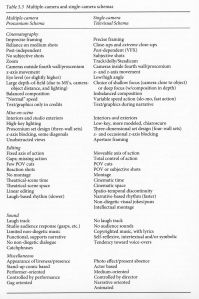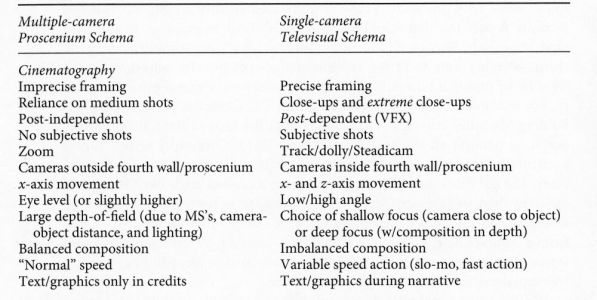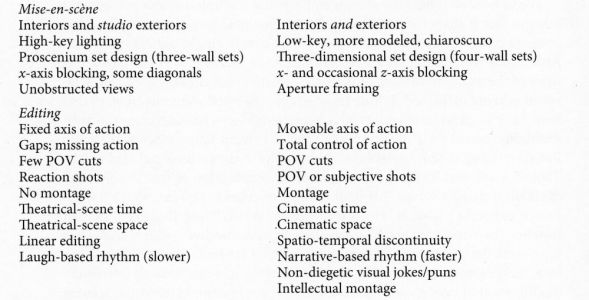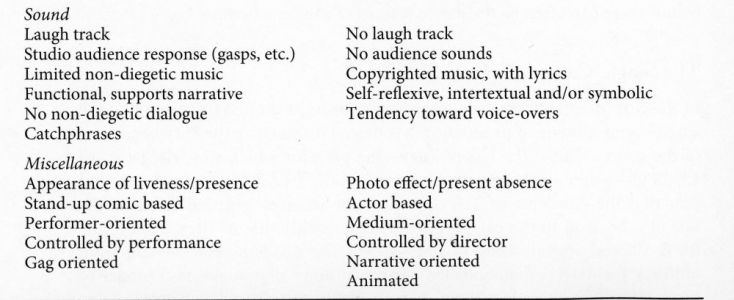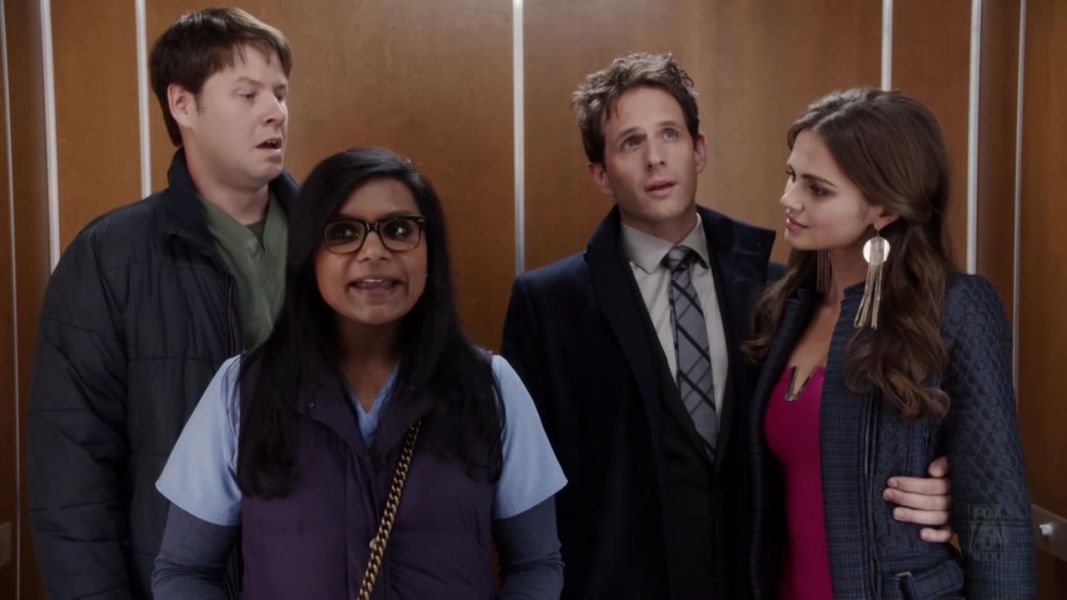Difference between pages "JCM312/French Feminism, Continued: Agnès Varda (Discussion)" and "Style and Stylistics (Discussion)"
From Screenpedia
(Difference between pages)
Jump to navigationJump to search (→Television: Visual Storytelling and Screen Culture: rewording) |
|||
| Line 1: | Line 1: | ||
| − | '' | + | ==''Television: Visual Storytelling and Screen Culture''== |
| − | #'''Group | + | #'''Group 1:''' Explain the work of "evaluative" and "descriptive" stylisticians. How might they approach ''The Mindy Project''? |
| − | + | #'''Group 2:''' Explain the work of "analytic" stylisticians. How might they approach ''The Mindy Project''? Be ready to define the following purposes or "functions" of style discussed in the textbook. | |
| − | #'''Group | + | #*symbolize |
| − | + | #*decorate | |
| − | + | #'''Group 3:''' Explain the work of "analytic" stylisticians. How might they approach ''The Mindy Project''? Be ready to define the following purposes or "functions" of style discussed in the textbook. | |
| − | + | #*persuade | |
| − | + | #*hail or interpellate | |
| − | * | + | #*differentiate |
| − | * | + | #'''Group 4:''' Explain the work of "evaluative" and "descriptive" stylisticians. How might they approach ''The Mindy Project''? Be ready to define "craft practices" and "schemas." |
| − | |||
| − | |||
| − | |||
| − | |||
| − | ***''' | ||
| − | |||
| − | |||
| − | |||
| + | =="Televisuality and the Resurrection of the Sitcom in the 2000s"== | ||
<gallery mode="packed" heights=200px> | <gallery mode="packed" heights=200px> | ||
| − | File: | + | File:Table 5.3-resized.jpg|alt=Television Style, table 5.3|''Television Style'', table 5.3 "Multiple-camera and Single-camera Schemas," full table. |
| − | File: | + | File:Table 5.3 part 1 Cinematography.jpg|alt=Television Style, table 5.3|Table 5.3: Cinematography. |
| − | + | File:Table 5.3 part 2 MeS and Editing resized.jpg|alt=Television Style, table 5.3.|Table 5.3: Mise-en-Scene and Editing. | |
| − | File: | + | File:Table 5.3 part 3 Sound and Misc resized.jpg|alt=Television Style, table 5.3.|Table 5.3: Sound and Miscellaneous. |
| − | |||
| − | File: | ||
| − | |||
</gallery> | </gallery> | ||
| − | |||
| − | + | View a scene from ''The Mindy Project'' (see Blackboard and [http://tvcrit.org/Classes/Jbutler/BUI301/MindyProject_20131112/index.html screenshots online]). | |
| − | |||
| − | |||
| − | |||
| − | |||
| − | ''''' | + | *'''All Groups:''' List at least three aspects of the ''The Mindy Project'' scene that mark it as single-camera production. |
| + | *'''All groups:''' Table 5.3 in "Televisuality and the Resurrection of the Sitcom in the 2000s" lists elements of the "single-camera televisual schema". Is ''The Mindy Project'' "televisual", in addition to being a single-camera production? Identify any elements from this table in the scene. | ||
| − | + | <gallery mode="packed" heights=400px> | |
| − | + | File:Mindyproject 20131112qq00 00 55qq00040.jpg|alt=The Mindy Project screenshot.|Morgan, Mindy, Cliff, and Yana (from left). | |
| − | + | </gallery> | |
| − | |||
| − | |||
| − | |||
| − | |||
| − | |||
| − | |||
| − | |||
| − | |||
| − | |||
| − | |||
| − | |||
| − | |||
| − | |||
| − | |||
| − | |||
| − | |||
| − | |||
| − | |||
| − | |||
| − | |||
| − | |||
| − | |||
| − | |||
| − | |||
| − | |||
| − | |||
| − | |||
| − | |||
| − | |||
| − | |||
| − | |||
| − | |||
| − | |||
| − | |||
| − | |||
| − | |||
| − | |||
| − | |||
| − | |||
| − | |||
| − | |||
| − | |||
| − | |||
| − | |||
| − | ==Bibliography== | + | == Bibliography == |
| − | + | #Butler, Jeremy G. ''Television: Visual Storytelling and Screen Culture''. NY: Routledge, 2018. | |
| − | + | #Butler, Jeremy G. "Televisuality and the Resurrection of the Sitcom in the 2000s," in ''Television Style'' (NY: Routledge, 2010), 173-222. | |
| − | |||
| − | |||
==External links== | ==External links== | ||
| − | *[ | + | *[http://www.tvstylebook.com/pix/images-by-chapter/?album=1&gallery=15 ''Television Style'' illustrations] |
| − | *[ | + | *[http://www.tvstylebook.com/ ''Television Style'' official homepage] |
| + | *[http://tvcrit.org/Classes/Jbutler/BUI301/MindyProject_20131112/index.html ''The Mindy Project'' screenshots] | ||
| + | *[http://www.tcf.ua.edu/EO/DV/NewGirl.php ''New Girl'' clip] | ||
| + | *[http://tvcrit.com/find/howimet Hybrid mode of production] in ''How I Met Your Mother'' | ||
| − | [[Category: | + | [[Category:BUI301]] |
| + | [[Category:BUI301 Discussion]] | ||
| + | [[Category:JCM311]] | ||
| + | [[Category:JCM311 Discussion]] | ||
Revision as of 19:54, 21 October 2020
Television: Visual Storytelling and Screen Culture
- Group 1: Explain the work of "evaluative" and "descriptive" stylisticians. How might they approach The Mindy Project?
- Group 2: Explain the work of "analytic" stylisticians. How might they approach The Mindy Project? Be ready to define the following purposes or "functions" of style discussed in the textbook.
- symbolize
- decorate
- Group 3: Explain the work of "analytic" stylisticians. How might they approach The Mindy Project? Be ready to define the following purposes or "functions" of style discussed in the textbook.
- persuade
- hail or interpellate
- differentiate
- Group 4: Explain the work of "evaluative" and "descriptive" stylisticians. How might they approach The Mindy Project? Be ready to define "craft practices" and "schemas."
"Televisuality and the Resurrection of the Sitcom in the 2000s"
View a scene from The Mindy Project (see Blackboard and screenshots online).
- All Groups: List at least three aspects of the The Mindy Project scene that mark it as single-camera production.
- All groups: Table 5.3 in "Televisuality and the Resurrection of the Sitcom in the 2000s" lists elements of the "single-camera televisual schema". Is The Mindy Project "televisual", in addition to being a single-camera production? Identify any elements from this table in the scene.
Bibliography
- Butler, Jeremy G. Television: Visual Storytelling and Screen Culture. NY: Routledge, 2018.
- Butler, Jeremy G. "Televisuality and the Resurrection of the Sitcom in the 2000s," in Television Style (NY: Routledge, 2010), 173-222.
